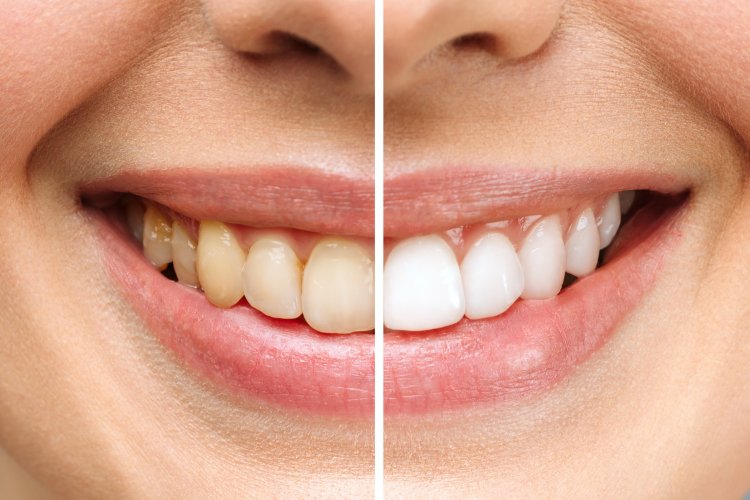Whiten Your Teeth Safely: Tips and Tricks from Dental Experts
Teeth whitening is a cosmetic dental procedure aimed at lightening the color of teeth to improve their appearance. Over time, teeth can become discolored due to food and beverages (such as coffee, tea, and red wine), tobacco use, and aging. Teeth whitening seeks to remove these discolorations and make your smile look more attractive.

Methods of Teeth Whitening
Teeth whitening methods are generally categorized into at-home whitening and professional dental whitening.
At-Home Teeth Whitening
Whitening Toothpastes
Whitening toothpastes contain mild abrasives that help remove surface stains. These toothpastes are used during daily teeth cleaning and are generally less effective than professional treatments.
Whitening Gels and Strips
These products contain low concentrations of bleaching agents that can be applied to the teeth. Strips or gels are left on the teeth for a specified period and can provide effective results with regular use.
Over-the-Counter Whitening Kits
These kits, often recommended by a dentist, include custom trays and whitening gels. The trays are custom-made to fit your teeth perfectly. The whitening gel is placed in the trays and worn for a specified duration.
Professional Teeth Whitening
In-Office Whitening
This treatment is performed by a dentist and involves higher concentrations of bleaching agents, often activated with light or laser. This method provides noticeable results in a short time.
Take-Home Professional Kits
Provided by the dentist, these kits include custom-made trays and whitening gels for at-home use. They can be as effective as in-office treatments but require longer use.
Teeth Whitening Procedures
Professional teeth whitening procedures typically involve the following steps:
Dental Examination
The dentist examines your teeth and gums to determine if you are a suitable candidate for whitening. If there are cavities, gum disease, or other dental issues, these need to be addressed first.
Cleaning
Before starting the whitening process, your teeth need to be professionally cleaned to remove surface stains and plaque, allowing the whitening agents to penetrate better.
Protection
Special barriers or gels are used to protect your gums and oral tissues. This prevents the bleaching agents from causing harm to sensitive areas.
Application of Whitening Agent
A whitening gel is applied to the teeth, usually containing hydrogen peroxide or carbamide peroxide. The gel penetrates the teeth and breaks down stains to whiten the teeth.
Use of Light or Laser
Some whitening procedures involve the use of special lights or lasers to enhance the effectiveness of the whitening agent. This helps the gel work faster and more effectively.
Waiting Period
The whitening agent needs to remain on the teeth for a specified period, which varies depending on the product and its concentration.
Cleaning and Rinsing
After the specified time, the whitening gel is cleaned off the teeth, and the mouth is thoroughly rinsed. The teeth may appear immediately whiter.
Advantages of Teeth Whitening
Aesthetic Improvement
Whiter teeth enhance the appearance of your smile and improve your overall look.
Increased Confidence
Bright, white teeth can boost your confidence and make you feel more comfortable in social situations.
Quick Results
Professional whitening treatments typically provide noticeable results in a short amount of time, offering immediate improvement.
Disadvantages of Teeth Whitening
Temporary Sensitivity
Whitening procedures can cause temporary sensitivity in the teeth and gums. This sensitivity usually subsides within a few days.
Non-Permanent Results
The effects of whitening are not permanent. Over time, teeth can become discolored again due to the consumption of staining foods, drinks, and tobacco. Regular maintenance and touch-up treatments may be necessary.
Cost
Professional whitening treatments are generally more expensive than at-home methods but offer faster and more effective results.
Tips for Teeth Whitening
Regular Brushing and Flossing
Keep your teeth clean by brushing at least twice a day and using dental floss. This helps prevent the buildup of surface stains and plaque.
Avoid Staining Foods and Drinks
Limit the consumption of coffee, tea, red wine, fruit juices, and tobacco, as these can cause discoloration.
Regular Dental Visits
Visit your dentist regularly for check-ups and professional cleanings. Your dentist can recommend the best care methods to maintain the results of whitening treatments.
Post-Whitening Care
After whitening treatments, use whitening toothpaste and other recommended products to maintain the brightness of your teeth.
Teeth whitening can provide satisfying aesthetic results with the right methods and consistent care. However, it is important to follow professional advice and maintain good oral hygiene to protect your dental health. Stay in regular contact with your dentist to preserve the health and beauty of your teeth.
Disclaimer:
The information provided in this article is for educational purposes only and should not be considered medical advice. If you have any health concerns or are experiencing symptoms, it is important to consult with a healthcare professional, such as a doctor or clinic, for proper diagnosis and treatment. Always seek the advice of your doctor or other qualified health provider with any questions you may have regarding a medical condition. Do not disregard professional medical advice or delay in seeking it because of something you have read in this article.
#TeethWhitening #DentalCare #OralHygiene #SmileBright #HealthyTeeth
Book Now
What's Your Reaction?





















